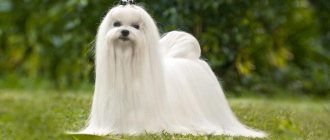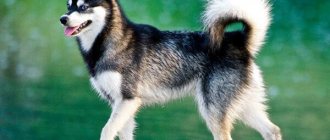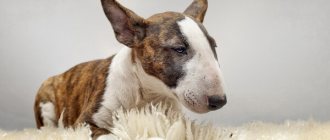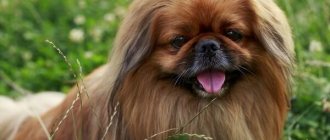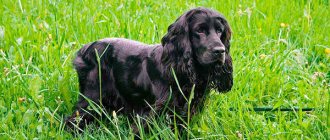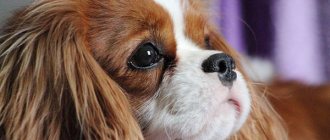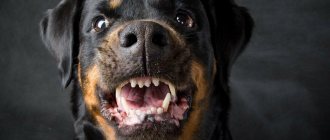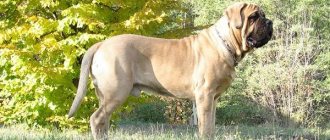Have you ever fallen in love with a handsome guy with a beard? What about the little lady with a thick bush of hair on her chin? We're talking about dogs, of course! And they don't just need these beards to look cute. It turns out that most bearded dogs were bred to hunt small game such as rodents, mice and burrowing animals. The beards protected their muzzles from animal bites, as well as from thorns, branches and anything else that a fearless dog might encounter while hunting.
Let's take a look at some of the most famous dog breeds with beards, as well as what it takes to care for those wonderful chin hairs.
Belgian Griffon
Small, playful dogs with a slightly curved forehead, short muzzle and wide skull were bred in Belgium around 1800. Griffons are great companions that require constant mental and physical stimulation. They are somewhat stubborn and picky and cannot tolerate small children of any age. Some males have an increased appetite, so carefully monitor their diet and do not leave food freely available. Clean your thick mustache and drooping beard daily from food debris and any dirt, and comb it. Periodically trim any excess hair that gets into the corners of your eyes to avoid irritation. The optimal number of walks per day is 2-3. After going outside, be sure to wash your paws and undercoat with a special shampoo.
Belgian griffin
Health and life expectancy
The average lifespan of a Bearded Collie is 12.8 years. According to a survey of owners in the British Isles, bearded dogs live on average 13.4 years, while their relatives from Canada and the USA live 12 years. The oldest dog according to the British Kennel Club was 19.5 years old.
The most common causes of death in UK Bearded Collies were: old age, cancer, cerebrovascular disease, chronic renal failure, and hypoadrenocorticism.
The most common hereditary diseases in the breed are:
- Problems with the musculoskeletal system (arthritis, cruciate ligament rupture, elbow dislocation);
- Problems with the gastrointestinal tract (colitis, diarrhea);
- Urological diseases;
- Diseases of the endocrine system (hypothyroidism; Addison's disease);
- Skin problems (pemphigus, baldness, follicular dysplasia);
- Ophthalmological diseases (corneal dystrophy, cataracts, progressive retinal atrophy).
Giant Schnauzer
The Giant Schnauzer is a large, powerful animal with a rectangular elongated muzzle, a round black nose, egg-shaped eyes, thick eyebrows, a characteristic neat beard and drooping mustache. This breed is incredibly energetic, restless, and in some situations can become aggressive. Therefore, in a house where there are infants or children under 10 years old, it is not recommended to have such a pet. These dogs need long daily exercise walks with intense exercise lasting 40 minutes or more, regardless of the weather. Very often, Giant Schnauzers are used as yard watchmen. Approximately 2-3 times a week requires thorough cleaning with a stiff bristle brush. Wash your face after every meal. Trim the claws as they grow. A professional haircut is required at least 4 times a year. Organize a proper and balanced diet in consultation with your veterinarian.
Giant Schnauzer
Bullets
Another shepherd dog comes from Hungary. Today this breed is used as a hunting and guard dog. This is perhaps the funniest looking black dog - its long hair is woven into braids, similar to Rastafarian dreadlocks. From a distance, it looks like a large floor brush with a shiny black nose sticking out of it. Such dense wool allows the animal to endure frosty winters. Oddly enough, bullet braids do not require special care. There is no need to comb them, just go through them occasionally so that the fur does not stick together into large tangles. Such a dog needs an energetic owner who can walk with it for a long time.
Bearded Collie
The Bearded Collie, Birdie, or Bearded Collie is the oldest English breed, created in Scotland. These dogs have a medium but muscular build, a wide head, slanting coal-black eyes, and thick long hair that hangs slightly from the chin. The height of an adult is about 70 cm, so when feeding, you will need a bowl for bearded dogs on a stand to make it easier for the animal to reach. Be sure to include veal and beef liver in your diet for healthy joints. Birdie is distinguished by intellectual abilities, courage and gentleness of character. She shows kindness, affection and devotion, and is loyal to children and strangers. Approximately 1 hour a day should be devoted to training at specialized sites. Bearded men need periodic haircuts once a month, as well as daily brushing of the coat using hypoallergenic cosmetics.
Collie
Herding breeds
Bearded dogs are found among long-haired shepherd dogs. The hair on the body and head grows almost the same length. Hair growth above the eyes, on the cheeks, cheekbones and chin forms a thick beard, bangs hiding the eyes, and a bushy mustache.
Catalan Shepherd
These are the first Spanish dogs to gain worldwide recognition. At home, they became skilled assistants to farmers. Catalan Shepherds are famous for their independent thinking and ingenuity; they are able to manage a herd for a long time without the presence of a person.
Portuguese Shepherd
The dogs were bred in the Alentejo region of Portugal, where they still help herd and guard livestock. In their homeland, the animals’ facial expressions are seen to have a subtle resemblance to a monkey, which is why they are jokingly called “monkey dog.”
South Russian Shepherd
The animals look like huge shaggy lap dogs of white, light gray, fawn color. The length of the fur reaches 20 cm, and is almost the same size on the body and head. If you do not plan to take your pet to exhibitions, then the fur coat is trimmed to 5 cm.
Bouvier des Flanders
The literal translation of the name is “shepherd from Flanders.” According to the requirements of the standard, a mustache and a hard, heavy beard “should impart ferocity to the expression.”
Bearded Collie
Antique Scottish Cattle Dogs are medium sized. The name was given for the lush long hair all over the head and on the chin. Animals exhibit a curious property. Puppies are born dark. As they grow older, the hair lightens, and permanent color is formed only at 3 years.
Lhasa apso
The Lhasa Apso, or Lhasa, is a Tibetan guard variety with a lush, porous coat covering the entire body, with hanging ears and a tail slightly raised up. Lhasa is independent, capricious, hardy and moderately energetic. Such a pet treats other pets calmly and does not offend small children. Lhasa Apsos require periodic visits to the dentist to remove tartar and plaque. Take your dog to a professional groomer monthly for thorough care of unruly fur. After a walk, bathe the animal, washing away dirt with a soft brush. Walk your pet 2-3 times a day. If you find dirt in the ears, remove it with a cotton swab soaked in a solution of Chlorhexidine or chamomile decoction.
Lhasa apso
Basic content rules
The rules for keeping bearded dogs are no different from the principles of caring for any other animals. Mandatory care measures include:
An important feature of keeping bearded dogs is associated with the physiological characteristics of the animal, in particular, with non-standard hair. It is in relation to grooming that the animal needs additional measures that are not required in the process of caring for other types of dogs.
This applies to daily combing using special combs and brushes. Under no circumstances should tufts be allowed to form on the fur. In addition, be sure to groom (cut) the coat. To do this, contact specialists. Such care activities will not only ensure your pet’s neat and well-groomed appearance, but also its health.
Irish Wolfhound
The Irish Wolfhound is a hunting breed first bred by the ancient Celts. Its distinctive features are: a muscular large body, a long elongated head with a pointed muzzle, small ears, soft curly fur of gray, white or black color. This dog is not designed for apartments; it requires a large free space for outdoor games. Spend at least 50 minutes a day walking and exercising. Starting from early puppyhood (from 3 months), train your pet so that in the future he will be kind and socialized. The wolfhound is smart, brave and sensitive, and with proper upbringing, it is friendly to children and other pets. It should be trimmed twice a year. Clean your ears periodically. The diet can include both dry food and natural products.
Irish Wolfhound
Peculiarities
Traditionally, dogs with a beard are classified as companion pets. Such animals have a facial part overgrown with hair - the so-called beard. Depending on the specific breed, the ancestors of bearded dogs can be either guard dogs, herding dogs or even hunting breeds.
There is no single standard for bearded four-legged pets. They can differ from each other in size, color, physiological characteristics, behavioral patterns, etc. Their only common feature is the presence of an abnormally developed coat (in scientific circles it is called hypergrichosis).
In this regard, the animal's hair deserves special attention . Their positive characteristics include the fact that bearded dogs do not shed. But they have long hair growing all over the body, including the face, ears, paws, etc.
Hypergrichosis is a natural abnormality that was found in the first domesticated dogs. Over time, this “deviation” was consolidated by the works of breeders.
Lakeland Terrier
Lakeland Terriers appeared in England in the 17th century. They have a medium body size (up to 40 cm at the withers), curly light brown hair, an elongated muzzle with a curly beard. These pets love to bark loudly, both when threatened and when they are happy. Lakelands treat all family members equally, in some situations they can be amicable, and are easy to train. They need professional training and socialization, daily morning walks, and monthly coat trimming. Every day, wipe your eyes with chamomile infusion and cleanse your ears of wax. Trim the claws as they grow. Feed your pet fresh cottage cheese, boiled sea fish and beef, adding balanced dry mixtures to the menu.
Lakeland Terrier
Choosing a puppy
The Russian population of bearded collies is quite small; there are only a few nurseries specializing in their breeding. You only need to buy a puppy there and you will have to reserve your pet in advance. The breeder is obliged to provide the future owner with a puppy card, a veterinary book with vaccination records, copies of the parents' pedigrees, a breeding patent, a purchase and sale agreement and other documents.
Small bearded dogs are completely different from their parents, so they can be easily confused with many other purebred and outbred dogs. To understand all the nuances, you need a lot of experience, so it is better to seek help from a professional dog handler.
Biardid puppies look little like their parents
Price of a puppy of this breed
The cost of shaggy collie puppies varies from 30 to 65 thousand rubles. The specific amount is determined by the title of the parent couple, the prospects of the pet, its health, external data and other parameters.
Birdies are not a commercial breed, so advertisements for free sale are very rare. If one appears, and even at an attractive price, then this is a reason to suspect fraud.
Many years ago, in much the same way, we took an allegedly purebred German Shepherd puppy from a good person for almost nothing. The dog was taken for protection, but it was just right to protect it itself. She was frightened by any noise and hid in the farthest corner, but no one ever offended her, much less beat her. Cowardice turned out to be innate, coupled with the habit of chasing one’s own tail, which as a result of these exercises quickly lost its fur. Dealing with all this turned out to be extremely difficult and troublesome.
Polish Lowland Sheepdog
The Polish Lowland Shepherd is the oldest member of the Canidae family, with thick fur, a rounded muzzle and powerful, dense paws. These animals are kind, loyal and friendly, they love active activities and games, and when alone they can become very bored and sad. They are ideal for yard keeping. Due to its voluminous coat, the Polish Shepherd requires careful care: constantly comb and wash your pet, periodically visiting the groomer. Do not overfeed your pet, as this breed is prone to obesity. Create a three-course menu with vitamin and mineral supplements for proper and healthy development.
Polish Lowland Sheepdog
German dog
Aristocrat of the dog world. Great Danes are one of the tallest dog breeds at the withers. A wonderful security guard and bodyguard, full of dignity. It never barks in vain, and does not show aggression towards strangers without the owner’s command.
Like the Cane Corso, the Great Dane is a short-haired dog that does not tolerate cold well. The dog's coat is shiny and very dense. It is united with the “Corsican dog” by a common ancestor – the Tibetan mastiff. Despite its impressive appearance, this dog is not aggressive; it is almost invisible in the house, which is why it received the nickname “inconspicuous dog.”
Miniature Schnauzer
The miniature schnauzer is a semi-dwarf graceful dog (height at the withers 35-40 cm) with a shaggy elongated muzzle and black almond-shaped eyes. Its color is varied: from light beige to ash-gray. Average life expectancy is 10-15 years. Kindness, loyalty, tenderness, activity, friendliness are the main character traits inherent in these sweetest creatures. When walking in an unfenced area, try not to let your pet off the leash, otherwise he may run away. The peculiarity of the coat is that it does not shed. But still, a haircut is required every 5-7 weeks. Wash your beard immediately after eating. Shorten your nails 2-3 times a month. Periodically pluck the hairs in the area of the ears and eye sockets. The optimal diet for schnauzers should consist of foods that support vital energy: proteins and carbohydrates. The amount of feeding per day for an adult is 3-4 times.
Miniature Schnauzer
Briefly about the main thing
- There are a huge number of small dogs, each of them diverse and unique in their own way.
- Breeds of small dogs were bred not only for decorative purposes.
- The main thing is to choose your future pet wisely and take into account the breed’s temperament.
What other small breeds do you know? Write in the comments.
Did you like the article? Share it with your friends on social media. networks. This will help them get useful information and support our project.
Since childhood I have loved animals, in particular dogs. I read a lot of literature about them. I have a wonderful Shar Pei at home. I write articles about breeds and pet care with great pleasure.
Shih Tzu
The Shih Tzu, or chrysanthemum dog, is a small, neat animal with long, smooth fur. These are affectionate and devoted creatures, indifferent to other pets, preferring the company of their owner. The Shih Tzu's personality is fiery and playful. Correct training will require professional lessons with a trainer, walks on a short leash and learning commands at home. Start lessons from 4 months of birth. To prevent the formation of tangles and knots on the hair, comb the hair several times a day with semi-hard bristles. Bathe no more than once a month. Chrysanthemums are prone to plumpness, so optimize the amount of food - no more than 4 times a day in small portions. Introduce offal (liver, hearts and ventricles), boiled turkey and rabbit meat into your diet.
Shih Tzu
Education and training
In experienced and loving hands, birdie training is usually not difficult. The dog grasps everything on the fly, wants to please and be useful, and also deserve a treat. Raising a Bearded Collie puppy begins as early as possible. The baby is taught obedience and rules of behavior in the house, weaned from bad habits (jumping on everyone, whining, barking for no reason, etc.).
Bearded men are stubborn and independent to varying degrees. They definitely need to be trained. It is advisable to attend general obedience courses, where the dog can burn off its energy, practice commands and communicate with its relatives.
The Bearded Collie responds only to positive training methods. The worst punishment for them will be the disapproving look of the owner. People who yell or physically abuse a dog will most likely end up with an uncontrollable, neurotic dog with a ton of behavioral problems. Raising and training this energetic and curious dog can take a lot of time, but the results are worth it.
Skye Terrier
The Skye Terrier is a short, bearded breed (up to 24 cm at the withers), first bred on the island of the same name, located off the coast of Scotland. Distinctive features: dense muscular body, round brown eyes and pointed ears. The color can be anything: from white to black. These pets are suitable for sharing with older children who understand the basics of interacting with an animal. After all, Skye Terriers do not accept disrespect for personal space, assertiveness and annoyingness. They decide for themselves when they are ready to communicate. Walk for at least 30 minutes every day. At home, equip a special bed in the place your pet chooses. Do not have other domestic animals indoors, otherwise they will become a source of prey. Bathe your dog at least 2 times a week using special hypoallergenic shampoos.
Skye Terrier
Origin story
The Bearded Collie is one of the oldest breeds developed in the UK. But the use of the dog exclusively as a working dog and the lack of breeding records does not allow reliably tracking its origin. The first bearded dogs appeared in the 17th-18th centuries, perhaps earlier, but only at the beginning of the 20th century was an attempt made to standardize the breed.
The "collie" in the name does not indicate any relationship with other herding breeds such as the Rough Collie or Border Collie. Rather, it describes the dog's function as a "sheepdog." The term probably comes from the word "coaley" - a breed of dark-colored sheep that was bred in Scotland, or has Celtic roots, derived from the word "collie" - "useful".
The history of the appearance of bearded coli is a mixture of fact and speculation. According to individual reports and records, it is known that at the end of the 15th and beginning of the 16th centuries there was active trade between Scotland and Poland. Several Polish Shepherds were brought to the UK at that time. They mixed with local breeds and thus formed a new type of dog, which is the ancestor of modern bearded dogs. According to another version, these were not PNO, but kuvas or commanders. Since the beginning of the 19th century, images of dogs similar to birdies have been found in paintings and engravings. The first written description of dogs in Scotland was written by Thompson Gray (1880s). In 1912, a preliminary working standard was developed in Edinburgh and a breed club was opened.
In the past, the Bearded Collie has had many different names: Highland Collie, Old Welsh Gray Sheepdog, Highland Collie and others. Today he is often called simply Birdie (from the English beardie - “bearded man”). The First World War caused significant damage to the breed. In the 30s, Cameron Miller began the revival of bearded men. If not for her work, the breed could have completely disappeared. During World War II, the number of beards declined again. The loss of interest in them can also be attributed to the death of Mrs. Miller. Another significant role in the history of the breed also belongs to a woman - Mrs. Wilson. In 1944, by luck, instead of a Scottish shepherd, she received a bearded puppy. It was a bitch named Jenny who captivated Mrs. Wilson with her personality and appearance. Soon they found a partner for her - a male named Bailey Botkenner. It can be said that almost all modern bearded collies descended from this pair. The breed was recognized by the International Canine Federation in 1967.
Bearded collies have appeared in several films: Agent Cody Banks (2003), Shaggy Dog (2006), Hotel for Dogs (2009).
Purpose
The Bearded Collie is a hardy and reliable working dog, unpretentious to living conditions. Able to live and work even in harsh climatic conditions. Valued by shepherds for his loyalty and intelligence. Used mainly for grazing cattle and sheep. In its homeland, the bearded collie received the nickname “jumping bear”.
Working in dense underbrush on hillsides, these dogs will leap out of the bush to see their charges. When confronted by a stubborn sheep, they bark and jump on their front legs.
Modern dogs are often just pets or athletes. Various disciplines of canine sports are suitable for them: herding tests, agility, dog dancing, obedience, treyball.
Miniature Schnauzer
The Miniature Schnauzer, or Mittel, is an intelligent, but slightly stubborn protector and loyal friend. They choose and recognize only one owner, but treat other family members with respect. Aggression occurs extremely rarely: usually when meeting another dog on the street. Never shout or offend the animal, otherwise the animal will stop trusting you. For harmonious development, take your pet to an equipped area every day. Wash your paws and trim your beard regularly. Miniature schnauzers love swimming, so if possible, organize trips to a specialized pool, and in the summer to a local pond.
Miniature Schnauzer
Rottweiler
According to the standard, this breed is not completely black; there are red areas on the chest and face of the animal. The Rottweiler's build is stocky and muscular. The breed was originally bred to transport small loads, but now this dog serves as a guard. He is very jealous of his territory and is wary of strangers.
Read Top 20 smartest dogs - breeds with a high level of intelligence
The coat is very thick and short, requiring no special care. Due to their thick undercoat, they tolerate cold well. Dogs of this breed must be trained, and this should be done by professionals. An untrained Rottweiler can pose a threat even to its owners.
Drathaar
The Drathaar, or wirehaired German pointer, is a type of hunting dog developed in Germany in the late 19th century. Endurance, friendliness and obedience are the main character traits of the animal. German Drahthaars love small children, active games and under no circumstances show aggression towards strangers. A suburban area is ideal for keeping this breed, allowing for constant physical activity for the pet. Basic coat care: bathe twice a week, comb and trim once every 3 months. In the spring and summer, treat the undercoat with antiparasitic compounds, for example, Frontline. Drathaars are very fond of boiled buckwheat or millet cereals, beef and quail eggs.
Drathaar
Hunting dogs with beard
Thick, elongated hair grows on the chin in wirehaired pointers. The body is covered with short, close-lying hair. Against such a background, the beard on the muzzle is very noticeable.
Here are striking examples of bearded cops:
- Griffon Korthals. French breed, another name is the French Wirehaired Pointer.
The dogs were named after the first breeder, the Dutchman Eduard Kortal.
- Italian spinone. Researchers of the breed claim that the Spinone has never bitten anyone.
The Italian Spinone is equally adept at hunting on water and on land.
- Drathaar. The cops come from Germany.
Drathaar means “wool like wire” in German.
- The Czech fousek is very similar in appearance to the drathaar, sometimes even dog handlers confuse them.
Czech fuosek.
When talking about bearded hunting dogs, one cannot help but remember the dachshund. The breed breeds animals with three types of coat. Smooth-haired and long-haired species are devoid of hair on the face. The wire-haired dachshund has a distinct beard and eyebrows, although the body has coarse hair that lies close to the body.
Wire-haired dachshund.
Irish Blue Terrier
The Irish Blue Terrier, or Kerry Blue, is an elegant, stately dog with soft curly hair, a funny long beard and bushy eyebrows. Distinctive features: stubbornness, attentiveness, excellent attitude towards children. Be sure to be strict when training, otherwise the Kerry Blue may become willful and show character. Remember the basic rule of communicating with a blue terrier: never shout or raise your hand at the animal. Otherwise, you risk losing full contact with your “true friend.” The coat of these dogs is single-layer, so it practically does not shed. The main thing is to teach your pet to go to the groomer from puppyhood. There are no special instructions regarding catering. The number of feedings is 4 times a day.
Irish Blue Terrier
Peculiarities
Dog breeds with a beard are most often pets. Although their ancestors were different types of dogs. These dogs have growing hair on their face, which is called a beard.
What is the name of the bearded breed? Bearded dogs do not belong to any group; they can be completely different. They have one thing in common - the so-called beard. According to science, this phenomenon is called hypergrichosis.
All bearded dogs have unique coats. She does not shed, which is a definite advantage. But it is very long and grows everywhere, including the muzzle, paws, and ears.
Affenpinscher
The difficult to train, disheveled Affenpinscher is an old European breed. It began to be started in the mid-18th century. A long beard, drooping ears, short stature (up to 25 cm), a coal-black undercoat, and a high tail are the features that distinguish this dog. Affenpinschers are inquisitive and smart. They guard their own property (for example, toys) with special vigilance, so it will be quite difficult for them to get along in the same apartment with small children. Regularly trim the hairs growing near your eyes. Take daily long walks with outdoor games (running for a stick, frisbee or ball). Trim claws once every 4 weeks. Brush your teeth with a special brush.
Affenpinscher
The most intelligent, beautiful and unusual breeds of bearded dogs were described in this article. Protect, care and protect your pet, and then he will reciprocate your feelings. If you have any controversial issues with the organization of care and nutrition, we recommend that you contact your veterinarian.
How to choose?
If you have finally decided to get a bearded dog, then the first thing you should do is decide on a specific breed. In this sense, it is important to consider several factors.
- Appearance. It's no secret that we all want to have a beautiful and cute animal. However, in addition to subjective external signs, close attention should be paid to the size of the animal. Compare the size of the dog with the living space available to you. You should carefully consider whether the animal will fit in your apartment, whether it will be comfortable for you and the dog to coexist in the same area.
- Behavior and character. Before purchasing a puppy of a particular breed, carefully study the information regarding its character traits. For example, some animals do not get along well with children, the elderly, or other pets living in your home. Other species cannot tolerate prolonged loneliness. It is important to analyze such characteristics of the animal so as not to get unpleasant surprises later.
- Physiological needs. In this regard, it is important to understand what specific care the dog needs. For example, some breeds like to spend most of their time outdoors. There are varieties that require constant medical examination. Make sure that you can support all these activities from a financial, time and energy perspective.
Once you have decided on a specific breed, it is important to find an official nursery that breeds similar animals, or contact an individual breeder. One way or another, you should make sure that you are buying a purebred and healthy dog. To do this, check out the certificates and licenses, as well as other documents available to the seller.
The external condition of the puppy and its behavior are also important factors. The animal must be well-groomed and active.
If possible, examine the parent pair to ensure that the puppy was born from healthy parents and has not inherited any genetic diseases.
